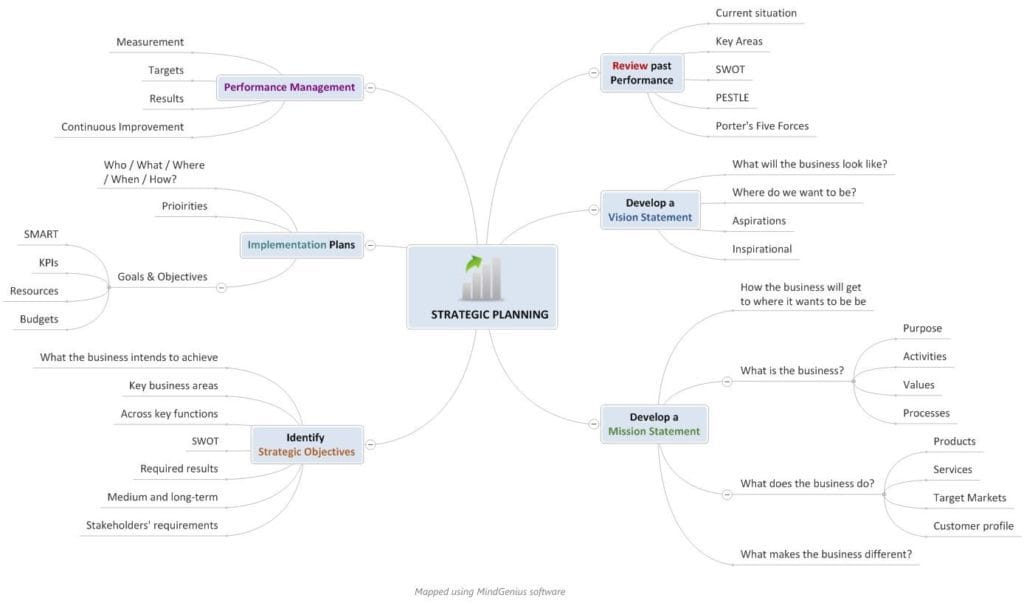Countless books and articles have been written on Strategy, Strategic Thinking, Strategic Planning and other associated topics on Strategy.
This short article provides a synopsis of the important area of Strategic Planning. Its aim is to act as a useful step-by-step guide to help with the sometimes-complex aspect of business planning.
What is Strategy?
In his book “The Rise and Fall of Strategic Planning”, Henry Mintzberg highlights some common views of strategy, they include:
- A plan, a “how”, a means of getting from here to there
- A pattern in actions over time
- Position; reflecting decisions to offer products or services in particular markets
- Perspective – vision and direction
Harvard Business School Professor Michael Porter argues that competitive strategy is “about being different”. He comments: “It means deliberately choosing a different set of activities to deliver a unique mix of value”. In one of his early books Porter defines competitive strategy as “a combination of the ends (goals) for which the firm is striving and the means (policies) by which it is seeking to get there”.
There are many textbook definitions for a Strategic Plan, but in basic terms it could be described as:
- A high level roadmap for the business
- A “compass” for the business vision and direction
- A platform for communicating the vision, mission and goals for the business
The following mind map provides a visual overview of a typical Strategic Planning framework…

1. Review Past Performance
Most Strategy Planning starts with a review of past performance – a critical look at “current situation” where each area of the business is reviewed in terms of performance, what worked well, what didn’t go so well, and areas for improvement
This is an important facet of kick-starting any strategic review or plan and provides meaningful insights into both positive and negative aspects of previous and/or current performance. There are many ways of doing this, including tools and techniques such as SWOT analysis, etc, but it is important to execute this part of the involving the right people (for credible and accurate insights and for decision-making and direction setting as the exercise progresses).
2. Develop a Vision Statement
A Vision Statement should be both an aspirational and inspirational description of where the business is going and what it aims to achieve in the medium to long-term.
It serves as a clear guide for the direction the business wishes to take, setting out the high level primary goals.
3. Develop a Mission Statement
A Mission Statement outlines the core purpose of a business and its reason for existing. It should help guide the business strategies, articulate its overall goals, provide a roadmap and guide any decision making.
A Mission Statement should also clearly outline products and services, which markets will be served and how; and communicate intended direction to the organisation, customers, and stakeholders.
4. Identify Strategic Objectives
At this stage, the aim is to develop a set of high-level Objectives for all areas of the business.
They need to highlight the priorities, goals and objectives that will ensure delivery of the vision and mission.
A view of the end-objectives and results required for each objective is a must.
Aligned with the first stage of Review, in particular the SWOT analysis, other key aspects of setting these objectives would be: building on the identified strengths; ensuring plans and actions are in place to take care of areas of weakness; identified opportunities are factored in and included; actions are in place to counter any perceived threats.
This stage is very much aligned with the next stage of implementation…
5. Implementation Plans
The distillation from the Vision, Mission and higher-level Strategic Objectives needs to filter down to Departmental, Team and individual Objectives and Action Plans.
The “who, what, where, when, and how” needs to be agreed and communicated.
Plans are now more “operational” and “process” aligned with SMART (specific, measurable, achievable, realistic and time-related) objectives agreed and put in place.
These objectives also need to take into account Performance Indicators, Resource allocation and budget requirements.
6. Performance Management
All the Objectives and Action Plans need to be continually reviewed against the agreed outcomes or Key Performance Indicators (KPIs).
Targets and results need be continually monitored and reviewed.
The whole Strategy and related objectives, plans, projects, etc, must be managed in such a way that strengths and weaknesses can be quickly and easily identified and acted on, with the ethos of continuous improvement and business excellence at the core of the strategy.
In terms of the executing and managing the whole end-to-end process of Strategic Planning, an increasing number of planners, managers, directors and business leaders are now turning to business mind mapping software to map, visualize, shape, present and communicate in key aspects of:
- Brainstorming sessions at the scoping and planning stages
- Creatively applying problem solving and other tools and techniques such as SWOT, etc.
- More efficient and focussed planning, running and follow-up of meetings
- Capturing individual and team contributions to ideas, knowledge and experience
- Gaining understanding on the both the big picture and component parts
- Better, well-informed decision making and prioritisation
- Scoping, planning and authoring documents, reports and presentations
- Creating, allocating, monitoring and managing Objectives, Tasks and Actions
- Planning, scheduling and managing Projects
For those of you engaged in any of the Strategic Planning process, from the initial performance review, through to implementing and managing objectives, actions, projects, etc., I would thoroughly recommend the use of mind mapping software.
It truly does augment and add value to your existing suite of daily-use applications through its highly intuitive and engaging “capture – visualize – manage” processes and functions, enabling increased productivity, clarity on all work activities and higher quality outputs (to name but a few!).

